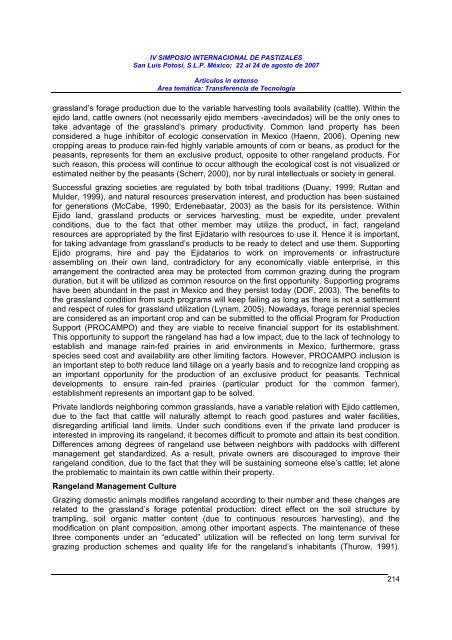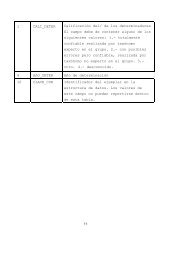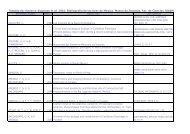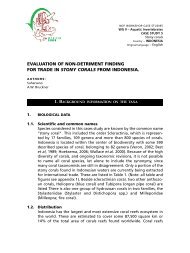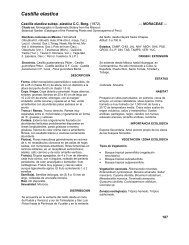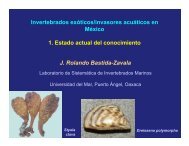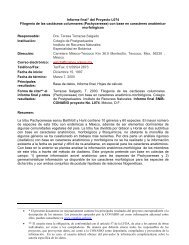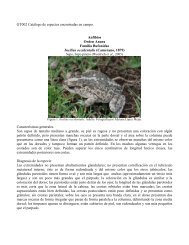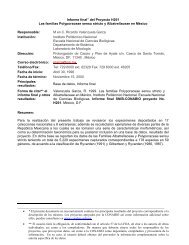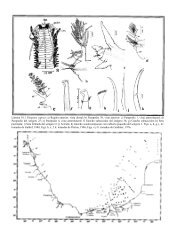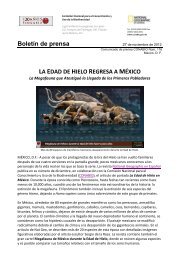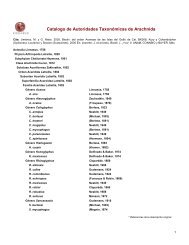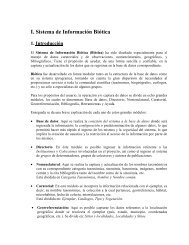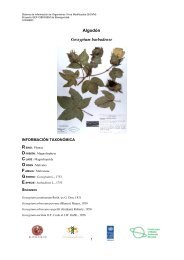ecosystem services to and from north american arid ... - Conabio
ecosystem services to and from north american arid ... - Conabio
ecosystem services to and from north american arid ... - Conabio
You also want an ePaper? Increase the reach of your titles
YUMPU automatically turns print PDFs into web optimized ePapers that Google loves.
IV SIMPOSIO INTERNACIONAL DE PASTIZALES<br />
San Luis Po<strong>to</strong>sí, S.L.P. México; 22 al 24 de agos<strong>to</strong> de 2007<br />
Artículos in extenso<br />
Área temática: Transferencia de Tecnología<br />
grassl<strong>and</strong>’s forage production due <strong>to</strong> the variable harvesting <strong>to</strong>ols availability (cattle). Within the<br />
ejido l<strong>and</strong>, cattle owners (not necessarily ejido members -avecindados) will be the only ones <strong>to</strong><br />
take advantage of the grassl<strong>and</strong>’s primary productivity. Common l<strong>and</strong> property has been<br />
considered a huge inhibi<strong>to</strong>r of ecologic conservation in Mexico (Haenn, 2006). Opening new<br />
cropping areas <strong>to</strong> produce rain-fed highly variable amounts of corn or beans, as product for the<br />
peasants, represents for them an exclusive product, opposite <strong>to</strong> other rangel<strong>and</strong> products. For<br />
such reason, this process will continue <strong>to</strong> occur although the ecological cost is not visualized or<br />
estimated neither by the peasants (Scherr, 2000), nor by rural intellectuals or society in general.<br />
Successful grazing societies are regulated by both tribal traditions (Duany, 1999; Ruttan <strong>and</strong><br />
Mulder, 1999), <strong>and</strong> natural resources preservation interest, <strong>and</strong> production has been sustained<br />
for generations (McCabe, 1990; Erdenebaatar, 2003) as the basis for its persistence. Within<br />
Ejido l<strong>and</strong>, grassl<strong>and</strong> products or <strong>services</strong> harvesting, must be expedite, under prevalent<br />
conditions, due <strong>to</strong> the fact that other member may utilize the product, in fact, rangel<strong>and</strong><br />
resources are appropriated by the first Ejidatario with resources <strong>to</strong> use it. Hence it is important,<br />
for taking advantage <strong>from</strong> grassl<strong>and</strong>’s products <strong>to</strong> be ready <strong>to</strong> detect <strong>and</strong> use them. Supporting<br />
Ejido programs, hire <strong>and</strong> pay the Ejidatarios <strong>to</strong> work on improvements or infrastructure<br />
assembling on their own l<strong>and</strong>, contradic<strong>to</strong>ry for any economically viable enterprise, in this<br />
arrangement the contracted area may be protected <strong>from</strong> common grazing during the program<br />
duration, but it will be utilized as common resource on the first opportunity. Supporting programs<br />
have been abundant in the past in Mexico <strong>and</strong> they persist <strong>to</strong>day (DOF, 2003). The benefits <strong>to</strong><br />
the grassl<strong>and</strong> condition <strong>from</strong> such programs will keep failing as long as there is not a settlement<br />
<strong>and</strong> respect of rules for grassl<strong>and</strong> utilization (Lynam, 2005). Nowadays, forage perennial species<br />
are considered as an important crop <strong>and</strong> can be submitted <strong>to</strong> the official Program for Production<br />
Support (PROCAMPO) <strong>and</strong> they are viable <strong>to</strong> receive financial support for its establishment.<br />
This opportunity <strong>to</strong> support the rangel<strong>and</strong> has had a low impact, due <strong>to</strong> the lack of technology <strong>to</strong><br />
establish <strong>and</strong> manage rain-fed prairies in <strong>arid</strong> environments in Mexico, furthermore, grass<br />
species seed cost <strong>and</strong> availability are other limiting fac<strong>to</strong>rs. However, PROCAMPO inclusion is<br />
an important step <strong>to</strong> both reduce l<strong>and</strong> tillage on a yearly basis <strong>and</strong> <strong>to</strong> recognize l<strong>and</strong> cropping as<br />
an important opportunity for the production of an exclusive product for peasants. Technical<br />
developments <strong>to</strong> ensure rain-fed prairies (particular product for the common farmer),<br />
establishment represents an important gap <strong>to</strong> be solved.<br />
Private l<strong>and</strong>lords neighboring common grassl<strong>and</strong>s, have a variable relation with Ejido cattlemen,<br />
due <strong>to</strong> the fact that cattle will naturally attempt <strong>to</strong> reach good pastures <strong>and</strong> water facilities,<br />
disregarding artificial l<strong>and</strong> limits. Under such conditions even if the private l<strong>and</strong> producer is<br />
interested in improving its rangel<strong>and</strong>, it becomes difficult <strong>to</strong> promote <strong>and</strong> attain its best condition.<br />
Differences among degrees of rangel<strong>and</strong> use between neighbors with paddocks with different<br />
management get st<strong>and</strong>ardized. As a result, private owners are discouraged <strong>to</strong> improve their<br />
rangel<strong>and</strong> condition, due <strong>to</strong> the fact that they will be sustaining someone else’s cattle; let alone<br />
the problematic <strong>to</strong> maintain its own cattle within their property.<br />
Rangel<strong>and</strong> Management Culture<br />
Grazing domestic animals modifies rangel<strong>and</strong> according <strong>to</strong> their number <strong>and</strong> these changes are<br />
related <strong>to</strong> the grassl<strong>and</strong>’s forage potential production: direct effect on the soil structure by<br />
trampling, soil organic matter content (due <strong>to</strong> continuous resources harvesting), <strong>and</strong> the<br />
modification on plant composition, among other important aspects. The maintenance of these<br />
three components under an “educated” utilization will be reflected on long term survival for<br />
grazing production schemes <strong>and</strong> quality life for the rangel<strong>and</strong>’s inhabitants (Thurow, 1991).<br />
214


